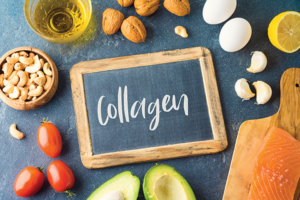 by Aliza Becker, BA, MPS
by Aliza Becker, BA, MPS
Collagen, a type of protein, is a primary structural component of the body that can be found in the skin, tendons, bones, ligaments, cartilage, and organs. Beginning with the discovery of Collagen II in the 1960s, at least 28 different types of collagen have been identified.1 All types of collagen have a triple-helix structure of three intertwined polypeptides strands, known as α-chains, which may vary in size according to the number of amino acids they contain.1 Depending on the type of collagen, these three α-chains may be identical to one another (e.g., Collagen II) or different (e.g., Collagen IX).1
Recommendations for Intake
The United States (US) Food and Drug Administration (FDA) to date has not provided daily, minimum, or maximum recommendations for the intake of collagen itself. However, research suggests an intake of 2.5 to 15 grams of functional collagen peptides per day is safe,2 and collagen peptides may be substituted into the diet to meet up to 36 percent of the body’s daily protein needs without upsetting the balance between nonessential and essential amino acids.2 Because it lacks the essential amino acid tryptophan, collagen is considered an incomplete protein source.2
Collagen may be sourced either in a direct form by consuming certain animal products that contain it or indirectly by consuming foods that contain the materials (i.e., amino acids) necessary for collagen production within the body. For an individual seeking to gain collagen by supplementing, products containing hydrolyzed collagen, or collagen peptides, are preferable as they provide collagen in a form that has been broken down already into its basic amino acids. Hydrolyzed collagen has traditionally been extracted from bovine and porcine sources, but religious and health (e.g., swine flu, bovine spongiform encephalopathy) concerns have facilitated increased interest in marine sources as an alternative.3 Other, less common sources of collagen, including chickens, ducks, frogs, and rabbits, have been explored.3
In addition to the specific amino acids required for the collagen end-product, ascorbic acid (vitamin C) is a necessary cofactor for the two enzymes involved in the process of collagen synthesis,4 which are prolyl hydroxylase (which stabilizes the collagen molecule) and lysyl hydroxylase (which facilitates collagen cross-linking to promote tensile strength and stability in tissue). Research has suggested that the presence of adequate vitamin C has particular benefits in Collagen I synthesis and bone fracture healing.5
Effects in the Human Body
Collagen loss from the body begins around 18 to 29 years of age, and the human body loses around one percent of its collagen annually after the age of 40 years.3 Other factors, such as the presence of free radicals, poor diet, smoking, alcoholism, and/or chronic disease, can also increase this rate.3 The rate of collagen production also continually decreases with age by as much as 75 percent by 80 years of age.3
Broadly, collagens can be subdivided into several categories (fibrillary, fibril-associated, and network-forming) according to their role(s) in the human body. Collagen I, a fibrillary collagen found in nearly all connective tissues of the body, plays a role in mechanical support and structural organization in the extracellular matrix (ECM);7 Collagen II is found predominantly in cartilage tissue;8 and Collagen III is a major structural component of hollow organs, including large blood vessels, the uterus, and the bowel.9 During Collagen I fibrillogenesis, Type III collagen also regulates fibril thickness in skeletal tissues,10 while Collagen V, present in most connective tissue matrices,9 restricts fibril diameter.11 As a fibril-associated collagen, Collagen IX is found in cartilage, where it acts as a macromolecular bridge between fibrils and other ECM components and is important for the “cohesive and compressive” properties of cartilage,12 while Collagen XVI contributes to the structural integrity of the dermo-epidermal junction by playing a role in the interaction between connective tissue cells and the ECM.13 Finally, Collagen VI, as a network-forming collagen, acts as a bridge between ECM components and surrounding tissue to facilitate three-dimensional organization of bone, tendon, cartilage, and skeletal muscle tissues.14
A number of hereditary diseases have been linked to mutations in the genes that provide instructions for making molecules of the different types of collagen. For example, mutations in COL1A1 and COL1A2 (Type I collagen) lead to osteogenesis imperfecta and several types of Ehlers–Danlos syndrome,15 while those in COL4A1 (Type IV collagen) have been linked to cerebral small-vessel disease.16 Separately, however, a number of acquired autoimmune diseases known as collagen vascular diseases may arise in susceptible individuals. These conditions include those in which the body begins to attack its own collagen, causing tissue weakening and breakdown, such as systemic lupus erythematosus, polymyositis (affecting the muscles), dermatomyositis (affecting the skin), and polyarteritis nodosa (affecting the arteries), and those that result in an overproduction and accumulation of collagen in the body, such as scleroderma.17
Extensive research on the use of collagen for therapeutic purposes has been conducted. One study found that oral administration of collagen peptides improved the skeletal muscle mass of patients in a rehabilitation ward following bone fracture or stroke.18 A randomized, controlled trial similarly suggested that oral Collagen II supplementation may have positive effects on inflammation and degradation in joint diseases such as osteoarthritis.19 Oral collagen supplementation may also increase skin elasticity, hydration, and dermal collagen density.20 In a pilot study, an injection of bovine dermal collagen beneath the mucosa in the area of the lower esophageal sphincter led to improvements in 10 patients with gastroesophageal reflux.21 Finally, collagen has been used as a wound dressing,22 bone and skin graft material,23,24 and as a vascular closure device.25
In those taking certain medications, such as tranilast (an antiallergic drug),26 glucocorticoids,27 or large doses of sustained-release methylprednisolone (a corticosteroid),26 collagen synthesis may be impaired. Of note, however, tranilast inhibited collagen synthesis in scleroderma fibroblasts to the same extent as in normal fibroblasts and keloid fibroblasts to a greater extent, suggesting its therapeutic potential as an antifibrotic drug.26
Sources
1. Ricard-Blum S. The collagen family. Cold Spring Harb Perspect Biol. 2011;3(1):a004978.
2. Paul C, Leser S, Messer S. Significant amounts of functional collagen peptides can be incorporated in the diet while maintaining indispensable amino acid balance. Nutrients. 2019;11(5):1079.
3. León-López A, Morales-Peñaloza A, Martínez-Juárez VM, et al. Hydrolyzed collagen—sources and applications. Molecules. 2019;24(22):4031.
4. Pinnell SR. Regulation of collagen biosynthesis by ascorbic acid: a review. Yale J Biol Med. 1985;58(6):553–559.
5. DePhillipo NN, Aman ZS, Kennedy MI, et al. Efficacy of vitamin C supplementation on collagen synthesis and oxidative stress after musculoskeletal injuries: a systematic review. Orthop J Sports Med. 2018;6(10):2325967118804544.
6. Kadler KE, Holmes DF, Trotter JA, Chapman JA. collagen fibril formation. Biochem J. 1996;316(Pt 1):1–11.
7. Orgel JP, Miller A, Irving RC, et al. The in situ supermolecular structure of type I collagen. Structure. 2001;9(11):1061–1069.
8. Bakilan F, Armagan O, Ozgen M, Tascioglu F, Bolluk O, Alatas O. Effects of native type II collagen treatment on knee osteoarthritis: a randomized controlled trial. Eurasian J Med. 2016;48(2):95–101.
9. Kuivaniemia H, Tromp G. Type III collagen (COL3A1): gene and protein structure, tissue distribution, and associated diseases. Gene. 2019;707:
151–171.
10. Wang C, Brisson BK, Terajima M, et al. Type III collagen is a key regulator of the collagen fibrillar structure and biomechanics of articular cartilage and meniscus. Matrix Biol. 2020;85-86:47–67.
11. Birk DE, Fitch JM, Babiarz JP, et al. Collagen fibrillogenesis in vitro: interaction of types I and V collagen regulates fibril diameter. J Cell Sci. 1990;95(Pt 4):649–657.
12. Olsen BR. Collagen IX. Int J Biochem Cell Biol. 1997;29(4):555–558.
13. Grässel S, Unsöld C, Schäcke H, et al. Collagen XVI is expressed by human dermal fibroblasts and keratinocytes and is associated with the microfibrillar apparatus in the upper papillary dermis. Matrix Biol. 1999;18(3):309–317.
14. Cescon M, Gattazzo F, Chen P, Bonaldo P. Collagen VI at a glance. J Cell Sci. 2015;128(19):3525–3531.
15. Myllyharju J, Kivirikko KI. Collagens and collagen-related diseases. Ann Med. 2001;33(1):7–21.
16. Lanfranconi S, Markus HS. COL4A1 mutations as a monogenic cause of cerebral small vessel disease: a systematic review. Stroke. 2010;41(8):
e513–e518.
17. Mount Sinai. Collagen vascular disease. https://www.mountsinai.org/health-library/diseases-conditions/collagen-vascular-disease. Accessed March 7, 2021.
18. Baba M, Suzaki E, Taira K, et al. [Effect of collagen peptides on skeletal muscle mass in the elderly: an interventional study examining oral nutrition support for patients in a recovery-phase rehabilitation ward]. Nihon Ronen Igakkai Zasshi. 2020;57(3):291–299.
19. Bakilan F, Armagan O, Ozgen M, et al. Effects of native type II collagen treatment on knee osteoarthritis: a randomized controlled trial. Eurasian J Med. 2016;48(2):95–101.
20. Choi FD, Sung CT, Juhasz MLW, Mesinkovsk NA. Oral collagen supplementation: a systematic review of dermatological applications. J Drugs Dermatol. 2019;18(1):9–16.
21. O’Connor KW, Lehma GA. Endoscopic placement of collagen at the lower esophageal sphincter to inhibit gastroesophageal reflux: a pilot study of 10 medically intractable patients. Gastrointest Endosc. 1988;34(2):106–112.
22. Brett D. A review of collagen and collagen-based wound dressings. Wounds. 2008;20(12):347–356.
23. Muschler GF, Negami S, Hyodo A, et al. Evaluation of collagen ceramic composite graft materials in a spinal fusion model. Clin Orthop Relat Res. 1996;(328):250–260.
24. Horch RE, Stark GB. Comparison of the effect of a collagen dressing and a polyurethane dressing on the healing of split thickness skin graft (STSG) donor sites. Scand J Plast Reconstr Surg Hand Surg. 1998;32(4):407–413.
25. Eggebrecht H, Haude M, Woertgen U. Systematic use of a collagen-based vascular closure device immediately after cardiac catheterization procedures in 1,317 consecutive patients. Catheter Cardiovasc Interv. 2002;57(4):486–495.
26. Yamada H, Tajima S, Nishikawa T, et al. Tranilast, a selective inhibitor of collagen synthesis in human skin fibroblasts. J Biochem. 1994;116(4):892–897.
27. Cutronneo KR, Rokowski R, Counts FD. Glucocorticoids and collagen synthesis: comparison of in vivo and cell culture studies. Coll Relat Res. 1981;1(6):557–568.
28. Cohen IK, Diegelmann RF, Johnson ML. Effect of corticosteroids on collagen synthesis. Surgery. 1977;82(1):15–20.
 About the Author
About the Author
Ms. Becker is the managing editor of The Journal of Innovations in Cardiac Rhythm Management. She also works as a freelance editor and as a teaching assistant for the George Washington University’s Master of Professional Studies in Publishing program.





